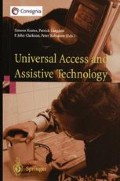Abstract
This chapter describes the development and evaluation of Web-based multimodal graphs designed for visually impaired and blind people. The information in the graphs is conveyed to visually impaired people through haptic and audio channels. The motivation of this work is to address problems faced by visually impaired people in accessing graphical information on the Internet, particularly the common types of graphs for data visualisation. In our work, line graphs, bar charts and pie charts are accessible through a force feedback device, the Logitech WingMan Force Feedback Mouse. Pre-recorded sound files are used to represent graph contents to users. In order to test the usability of the developed Web graphs, an evaluation was conducted with bar charts as the experimental platform. The results showed that the participants could successfully use the haptic and audio features to extract information from the Web graphs.
Access this chapter
Tax calculation will be finalised at checkout
Purchases are for personal use only
Preview
Unable to display preview. Download preview PDF.
References
Beggs J, Thede D (2001) Designing Web Audio — RealAudio, MP3, Flash and Beatnik. O’Reilly
Challis BP and Edwards ADN (2001) Design Principles for Tactile Interaction. In: Proceedings of Haptic Human-Computer Interaction, Springer, pp 17–24
Department of Health, Hospital Activity Statistics (2001) Available at: http://www.doh.gov.uk/hospitalactivity/index.htm
Fritz JP, Bamer KE (1999) Design of a haptic data visualisation system for people with visual impairments. IEEE Transactions on Rehabilitation Engineering 7(3): 372–384
Hardwick A, Fulmer S, Rush J (1998) Tactile display of virtual reality from the World Wide Web — a potential access method for blind people. Displays (18): 153–161
Hart SG, Wickens C (1990) Workload assessment and predication. In: MANPRINT, an approach to systems integration, Van Nostrand Reinhold, New York
Mynatt ED, Weber G (1994) Nonvisual presentation of Graphical User Interfaces: Contrasting two approaches. In: Proceedings of ACM CHI 94, ACM Press, New York, pp 166–172
Nguyen K (1996) The accessible web: Web access through adaptive technology. Available at: http://www.utoronto.ca/atrc/rd/library/papers/WebAccess.html
Ramloll R, Yu W, Riedel B, Brewster SA (2001) Using non-speech sounds to improve access to 2D tabular numerical information for visually impaired users. In: Proceedings of BCS IHM-HCI 2001, Lille, France, Springer, pp 515–530
Ramstein C, Martial O, Dufresne A, Carignan M, Chasse P, Mabilleau P (1996) Touching and hearing GUI’s: Design issues for the PC-access system. In: Proceedings of ACM ASSETS 96, ACM Press, New York, NY, pp 2–9
Royal National Institute for the Blind (RNIB) (2001) Accessible web design. Available at: http://www.rnib.org.uk/digital/hints.htm
Web Content Accessibility Guidelines (W3C Recommendation 5-May-1999). Available at: http://www.w3.org/TR/1999/WAI-WEBCONTENT-19990505
Web Content Accessibility Guidelines 1.0 (W3C) (2001). Available at: http://www.w3.org/TR/WCAG10/
Wies EF, Gardner JA, Sile O’Modhrain M, Hasser CJ, Bulatov VL (2001) Web-based touch display for accessible science education. Haptic Human-Computer Interaction, LNCS 2058, Springer, pp 52–60
World Wide Web Consortium (W3C) (2001) Style sheet activity statement. Available at: http://www.w3.org/Style/Activity
Yu W, Ramloll R, Brewster S, Ridel B (2001) Exploring computer-generated line graphs through virtual touch. In: Proceedings of the 6th International Symposium on Signal Processing and Its Applications, IEEE, vol. 1, pp 72–75
Yu W, Brewster S (2002) Comparing two haptic interfaces for multimodal graph rendering, Accepted by IEEE VR2002, 10th Symposium on Haptic Interfaces for Virtual Environment and Teleoperator Systems (Haptics 2002), in Orlando Florida, 2002, IEEE
Editor information
Editors and Affiliations
Rights and permissions
Copyright information
© 2002 Springer-Verlag London
About this paper
Cite this paper
Yu, W., Reid, D., Brewster, S. (2002). Web-based Multimodal Graphs for Visually Impaired People. In: Keates, S., Langdon, P., Clarkson, P.J., Robinson, P. (eds) Universal Access and Assistive Technology. Springer, London. https://doi.org/10.1007/978-1-4471-3719-1_10
Download citation
DOI: https://doi.org/10.1007/978-1-4471-3719-1_10
Publisher Name: Springer, London
Print ISBN: 978-1-4471-3721-4
Online ISBN: 978-1-4471-3719-1
eBook Packages: Springer Book Archive

